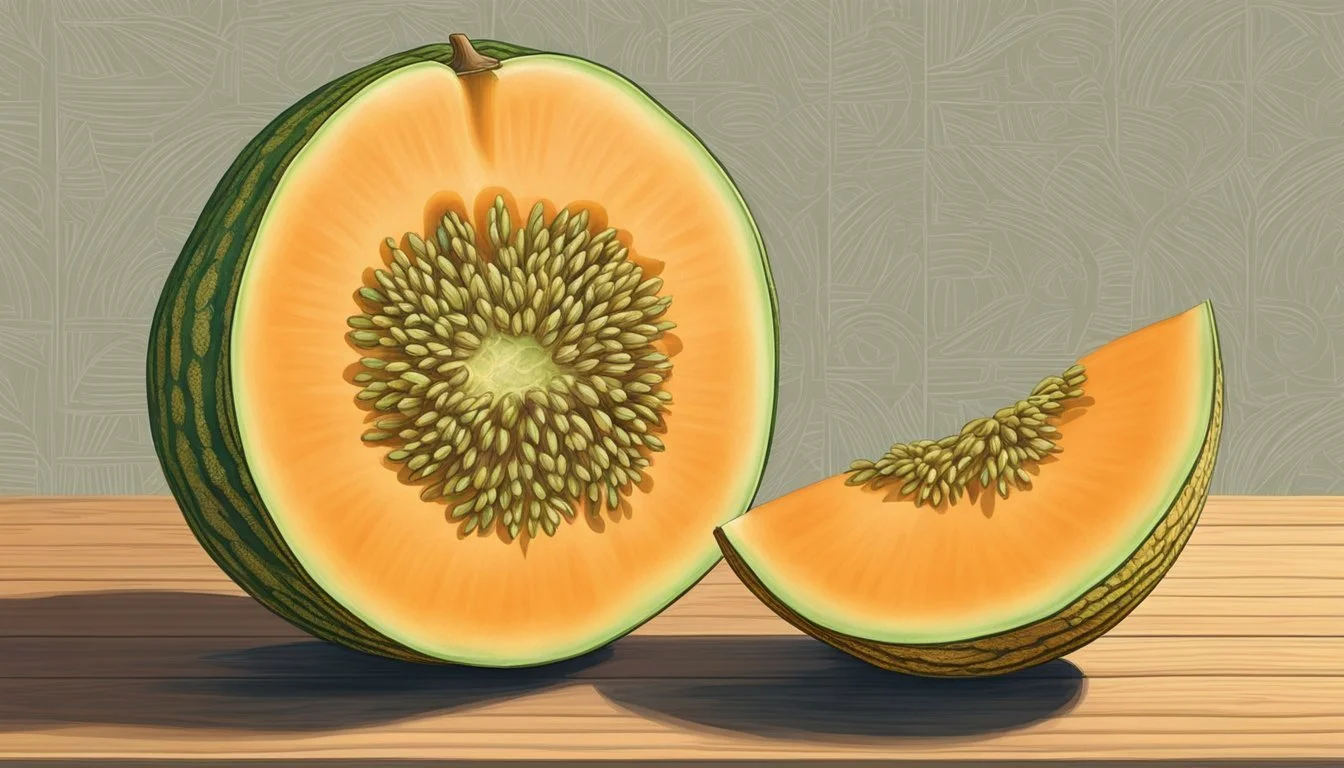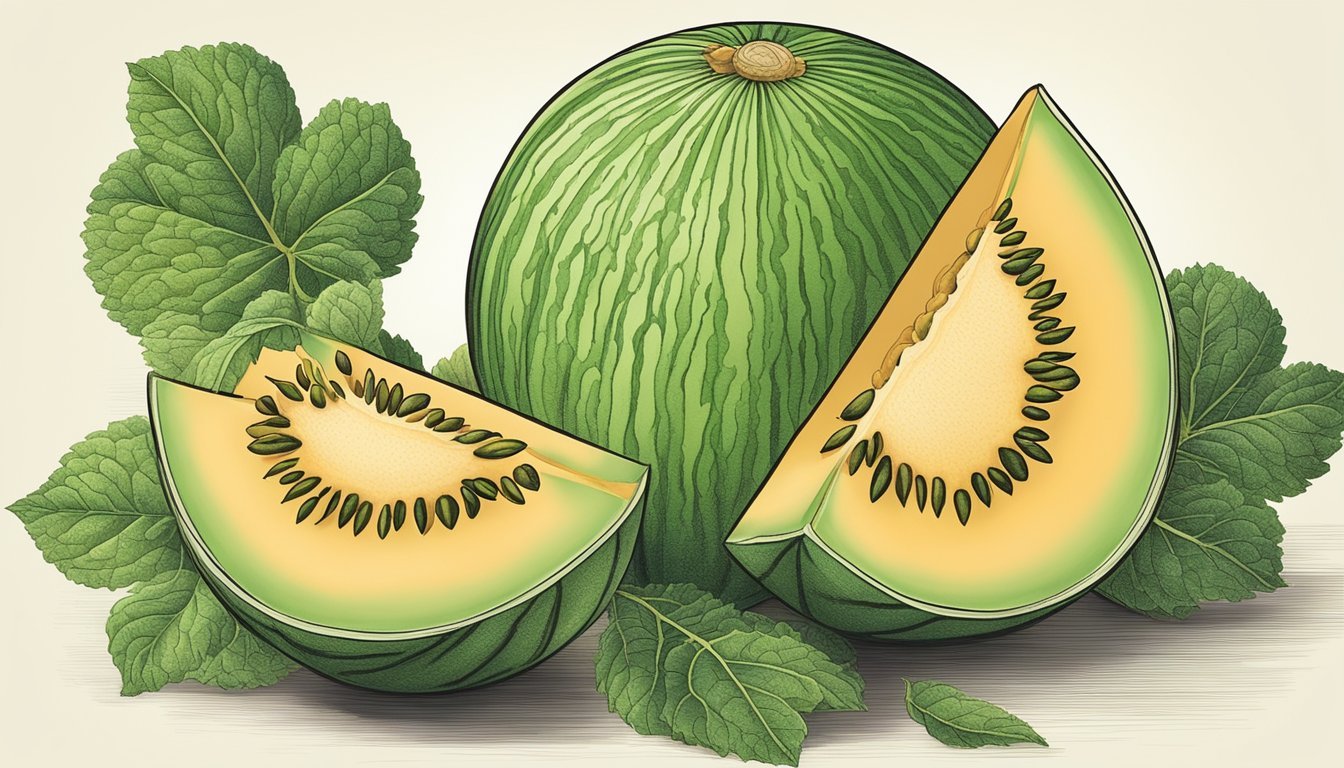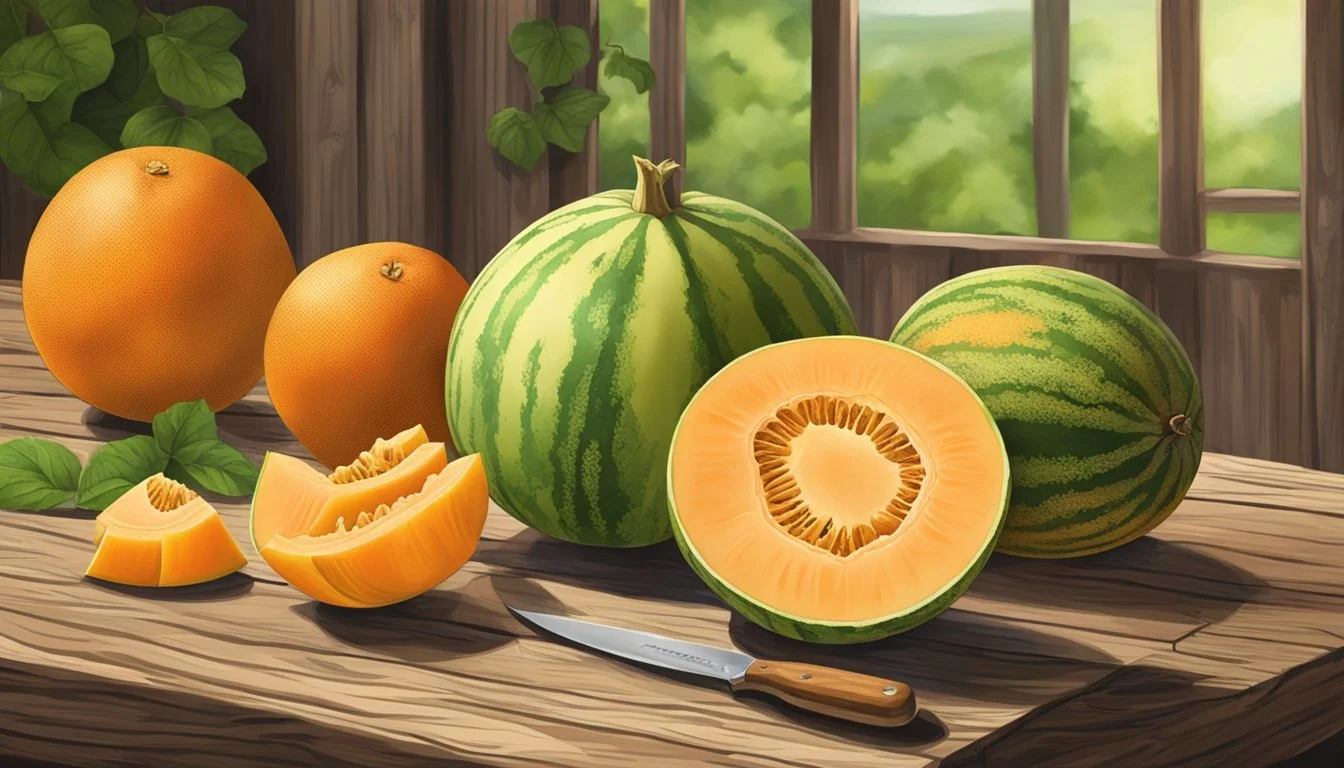How to Tell if a Charentais Melon is Ripe
Selecting the Sweetest Fruit
Determining the ripeness of a Charentais melon is key to enjoying its full, sweet flavor. This small, aromatic variety, typically known for its smooth rind and succulent orange flesh, offers a superior taste when ripe. Harvested primarily in France but also grown in other parts of the world, a well-ripened Charentais melon can provide a refreshing, juicy treat, especially during warm weather.
Identifying when a Charentais melon has reached its peak ripeness involves assessing various sensory indicators. The rind should appear slightly golden with pale green stripes, and the melon should feel heavy for its size, suggesting a high content of sweet juice. Furthermore, a ripe Charentais melon emits a fragrant aroma from the blossom end and displays a gentle give when pressed gently. For those selecting melons at a store or anticipating the harvest from their garden, understanding these visual and tactile cues ensures they capture the fruit at its most flavorful stage.
Key Takeaways
Assessing ripeness involves visual cues like color changes and tactile sensations such as weight and softness.
The fragrance at the blossom end and a hollow sound when tapped can indicate a ripe Charentais melon.
Store Charentais melons correctly and serve at peak ripeness for the best taste experience.
Identifying Ripeness
Proper assessment of a Charentais melon's ripeness hinges on examining several tactile and visual cues before indulging in its sweet, succulent fruit.
Color and Skin Observation
The Charentais melon, when ripe, exhibits a skin with a hue that transitions to a creamier, light yellow shade. Its surface should display a consistent coloration without any significant green tinges that often indicate immaturity.
Firmness and Give
A ripe Charentais melon should yield slightly to pressure, particularly at the blossom end. One should check for a firm yet supple texture, as a lack of give typically signals that the melon is not ready to be eaten.
Aroma and Scent
The scent is a telling sign of ripeness — a mature Charentais melon will emit a sweet and floral aroma. This will be most noticeable at the blossom end. Absence of a fragrance or an off-putting smell indicates that the melon is either underripe or overripe, respectively.
Stem and Blossom End Checks
The area around the stem should be examined for a gentle separation, which suggests the melon detached easily from the vine when ripe. Additionally, examining the blossom end opposite the stem—the softer, more rounded end of the melon—for a slight yielding to gentle pressure is important to confirm maturity.
Weight and Size Considerations
When selecting a Charentais melon, one should carefully consider its weight in relation to its size. A ripe Charentais typically feels heavy for its size, a characteristic indicative of its internal juiciness and dense flesh. The fruit's weight is a reliable indicator of its readiness for consumption.
Key Points to Assess:
Heft: Gently lift the melon. It should exhibit a substantial heft, signaling ample hydration and ripeness.
Size: Charentais melons are generally small to medium in size, growing about 6 inches in diameter and weighing between 3 to 4 pounds.
The shape of the melon is also a quality factor and Charentais melons typically maintain a uniform round to slightly oval shape. Irregularities in shape may affect the melon's internal development and could indicate inconsistent ripening or growth issues.
Inspect the melon's overall form; it should appear symmetrical and evenly rounded. This visual symmetry often goes hand-in-hand with a well-distributed internal structure, hinting at a consistent texture and flavor throughout the fruit.
In summary, assessment of weight and size yields important cues regarding the maturity of Charentais melons. Those who choose melons guided by these considerations are more likely to enjoy a sweet and satisfying experience.
Sound and Touch Techniques
Selecting a ripe Charentais melon requires attention to its acoustic properties and tactile feedback. Using the sound test and assessing firmness provides a reliable means of gauging ripeness.
Tapping Test
To perform the tapping test, one should gently tap the melon with a finger or knuckle. The resulting sound can be very telling:
Ripe Melon: Emits a deep and hollow sound.
Unripe Melon: Produces a dull or flat sound.
This simple test aids in discerning the melon's readiness for consumption.
Pressing for Ripeness
When it comes to pressing for ripeness:
Texture and Firmness: One should press gently on the opposite end of the stem. A subtle give indicates the internal flesh is softening, hinting at ripeness.
Soft Spots: Be cautious of excessive softness that might indicate over-ripeness or spoilage.
By integrating these sound and touch techniques, one can confidently select a Charentais melon at the peak of its sweetness and flavor.
Selecting Melons at the Store
When choosing a Charentais melon, shoppers should focus on visual cues, overall feel, and scent to ensure the fruit's ripeness and sugar content.
Visual Inspection
A ripe Charentais melon is visually distinctive by its skin color and condition. One should look for a melon that displays pale gold skin with blush-green stripes along its segments. The absence of bruises and a clean appearance are essential. The stem end, or "tail," should be inspected for a thick, green hue, which is a good indicator that the melon was picked recently.
Handling and Sensory Evaluation
Upon handling a Charentais melon, it should have a substantial weight for its size. This is generally an indication that the melon is laden with sweet juice and flesh. Gently pressing on the opposite end of the stem (the blossom end) should yield a slight give, which suggests optimal ripeness.
When it comes to scent, a ripe Charentais melon will emit a fragrant aroma reminiscent of a honeydew melon. One should take the time to sniff at the blossom end, as a sweet aroma is a telltale sign of a melon that is ready to eat. It’s important that this scent is noticeable but not overpowering, as an overly strong smell could indicate overripeness or spoilage.
Optimal Storage Techniques
To maintain the quality and flavor of Charentais melons, proper storage techniques are crucial. Both short-term and longer-term methods are beneficial depending on the intended use and the current ripeness of the fruit.
Short-Term Strategies
For Charentais melons that one plans to consume within a few days, storing at room temperature is best. They should be kept in a cool, well-ventilated space away from direct sunlight to preserve their sweetness and textural integrity. The melon's firmness will slightly soften, indicating a further progression in ripeness and flavor enhancement.
Do:
Store at room temperature.
Keep away from sunlight.
Do Not:
Store near ethylene-producing fruits if not wishing to hasten ripening.
Longer-Term Preservation
Once a Charentais melon reaches its peak ripeness or if one needs to store it for more than a couple of days, refrigeration is recommended. The colder temperature slows down the ripening process, extending the melon's shelf life. Before storing in the refrigerator, one should ensure that the melon is dry to avoid any potential moisture-related spoilage.
Storage Tips:
Wrap the melon in plastic wrap or store it in an airtight container before refrigerating to retain the melon's moisture and prevent absorption of other flavors.
Place in the crisper drawer where the temperature is more stable.
Using these techniques will help maintain the Charentais melon's desired firmness and delectable flavor for an extended period.
Serving Suggestions and Pairings
When it comes to serving a ripe Charentais melon, the goal is to highlight its sweet and juicy nature. For a simple yet elegant presentation, using a melon baller can create visually appealing melon spheres. These can be served as a refreshing addition to a breakfast fruit salad or as a delicate appetizer.
Pairing Charentais melon with complementary flavors can enhance its natural sweetness. Try combining it with the tartness of citrus fruits, such as oranges or grapefruits, to create a balanced and vibrant dish. Add some mint for a refreshing twist or a drizzle of honey for extra sweetness.
Blueberries and strawberries are excellent berries to pair with Charentais melon. They not only add a variety of colors but also introduce different textures and flavors that complement the melon.
For those who favor the combination of sweet and savory, consider preparing the melon cubed and wrapped in cured ham, creating a classic fusion of flavors. The saltiness of the ham contrasts perfectly with the melon's succulence, making for a sophisticated hors d'oeuvre.
Lastly, for an adventurous palate, a spicy element can elevate the experience. A Chilean spicy melon-mango salsa is a unique way to serve this melon, offering a kick that punctuates the Charentais melon's sweetness.
By considering these serving suggestions and pairings, one can truly appreciate the versatility of the ripe Charentais melon in a variety of culinary settings.
Understanding Melon Varieties
When selecting melons, it's vital to understand the differences between varieties to ensure the purchase of perfectly ripe and sweet fruit.
Charentais Versus Cantaloupe
Charentais melons are often confused with cantaloupes, but there are distinct differences. The true French Charentais, developed in the Poitou-Charentes region of France, is smaller and usually more aromatic than most cantaloupes. It is known for its deep orange, sweet flesh and smooth rind with green stripes. The standard cantaloupe, by contrast, typically has a netted rind and might not be as intensely flavored as its French cousin. Furthermore, the cantaloupes commonly found in American commerce are actually muskmelons.
Uncommon Varieties
Beyond the well-known melon types like Charentais and cantaloupe, there are several uncommon varieties that pique the interest of fruit lovers and farmers alike. Honeydew melons are known for their smooth, pale rind and sweet, green flesh. Then there's the watermelon, with its hard green rind and juicy, sweet interior. These less common melons each offer unique flavors, textures, and ripening indications, and they highlight the diversity found within melon farming.
Harvesting and Growth Insights
When dealing with Charentais melons, understanding the optimal growing conditions and precise harvest timing are essential for producing sweet, aromatic fruit.
The Role of Growing Conditions
Charentais melons thrive in warm, temperate climates resembling their origins in France. They require consistent sunlight and well-drained soil with a pH between 6.0 and 6.8. Farmers should ensure the soil is rich in organic matter and maintain proper moisture levels throughout growth.
Temperature: Ideal daytime temperatures hover around 75-90°F (24-32°C), while cooler night temperatures between 60-70°F (15-21°C) promote sugar accumulation in the fruit.
Soil Preparation: Before planting, incorporate compost or aged manure to a depth of 6-8 inches to create the nutrient-rich environment these melons desire.
Water Requirements: Keep the soil evenly moist during the growing season, particularly during fruit set and development.
When to Harvest
Determining the right time to harvest is crucial for achieving perfectly ripe Charentais melons.
Color Change: Look for a transition from green to creamy yellow on the rind—a key indicator of ripeness.
Skin Texture: A slight wrinkling upon close examination can also signal that the melon is ready for picking.
Fragrance: Ripe melons emit a sweet, fragrant aroma at the blossom end.
Sound: Tap the melon gently; a ripe one will have a subtly different hollow sound compared to an unripe one.
Harvest typically occurs in late summer, aligning with the peak seasonal conditions that Charentais melons prefer. If grown properly, farmers can present their fragrant and juicy melons at farmers' markets during this period, signaling the culmination of proficient cultivation from spring planting to summer's end.
Frequently Asked Questions
Q: How can one tell if a Charentais melon is ripe?
A: One can judge the ripeness of a Charentais melon by:
Appearance: The skin should veer towards pale gold with blush-green stripes.
Fragrance: A ripe melon emits a sweet, aromatic scent.
Stem Tenderness: The stem end becomes slightly tender upon pressure.
Sound: A hollow sound when tapped indicates ripeness.
Q: What visual cues indicate a Charentais melon has vibrant, orange flesh without cutting it?
A: The skin color changes from green to a pale gold which suggests the inside is likely to be the desirable vibrant orange.
Q: What is the difference in flavor between a ripe and an unripe Charentais melon?
A: A ripe melon will have a sweet flavor and juicy texture, while an unripe one may taste bland and less juicy.
Q: Can you ripen a Charentais melon after it's been harvested?
A: They can ripen after being picked, but not as effectively as when on the vine. It's best to consume them within a week of purchase for optimal flavor.
Q: What vitamins can be found in a ripe Charentais melon?
A: These melons are rich in vitamins, notably Vitamin A and C, which are associated with the vibrant orange flesh.
Q: Is a Charentais melon the same as a muskmelon?
A: While both belong to the muskmelon family, a Charentais melon is a specific type known for its sweet, aromatic qualities.





